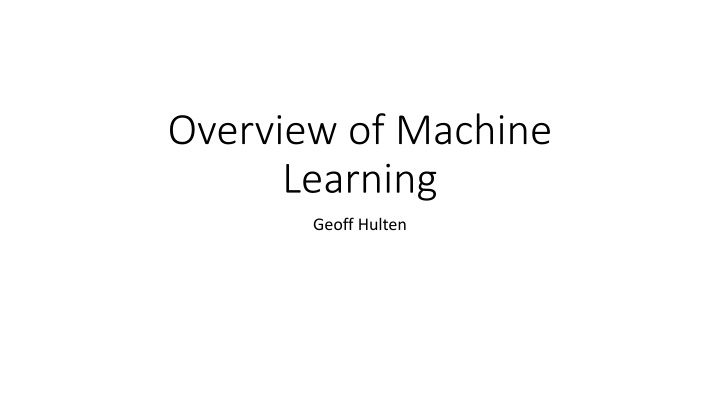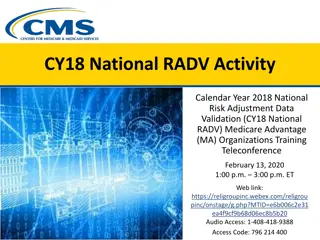
Machine Learning: Overview, Definitions, Algorithms, and Components
Explore the world of machine learning through an overview, definitions, successful applications, reasons for using ML, various algorithms, and key components of ML solutions and algorithms. Understand the importance and impact of machine learning in various industries.
Download Presentation

Please find below an Image/Link to download the presentation.
The content on the website is provided AS IS for your information and personal use only. It may not be sold, licensed, or shared on other websites without obtaining consent from the author. If you encounter any issues during the download, it is possible that the publisher has removed the file from their server.
You are allowed to download the files provided on this website for personal or commercial use, subject to the condition that they are used lawfully. All files are the property of their respective owners.
The content on the website is provided AS IS for your information and personal use only. It may not be sold, licensed, or shared on other websites without obtaining consent from the author.
E N D
Presentation Transcript
Overview of Machine Learning Geoff Hulten
Definitions of Machine Learning Machine learning is a branch of artificial intelligence based on the idea that systems can learn from data, identify patterns and make decisions with minimal human intervention. A computer program that can learn from experience E with respect to some class of tasks T and performance measure P, so that its performance at tasks in T, as measured by P, improves with experience E.
Successes of Machine learning Web search Finance / Trading Marketing Fraud and Security E-commerce Robotics Self Driving Cars Health Care Social networks Recommendations NLP / Digital Assistants Kinect Alpha Go [Your favorite area]
Why Machine Learning Why not ML? Simple Problems Deterministic Problems Static Problems Problems efficiently solved Situations for ML: Big problems Open ended problems Time changing problems Intrinsically hard problems
Machine Learning Algorithms Tens of thousands of machine learning algorithms, hundreds new every year Types of Machine Learning Algorithms: Supervised (inductive) learning Training data includes desired outputs Unsupervised learning Training data does not include desired outputs Semi-supervised learning Training data includes a few desired outputs Reinforcement learning Rewards from sequence of actions
Components of a ML Solution Training data Context Features Labels Training Examples Deployment Models Interacting with users Observations & Telemetry Orchestration Adapting over time Dealing with mistakes Maintaining Balance Training environment Processing Learning algorithms Evaluation
Components of a ML Algorithm Loss Function (Evaluation) Model Structure (Representation) Fitting Parameters (Optimization) Linear Models Decision trees Ensembles of models Instance based methods Neural networks Support vector machines Graphical models (Bayes/Markov nets) Etc. Greedy search Gradient Descent Linear Programming Many variations Accuracy Precision and recall Squared error Likelihood Posterior probability Cost / Utility Margin Entropy K-L divergence Etc.
Brief Review of Data Unstructured Data Collection of e-books Crawl of 1,000,000 web pages The raw contents of your hard drive Images of every product in a product catalogue Structured Data Numerical Categorical Binary Text Relational Etc Number of Pages Year Best SellerHasWord Book Title Genre Author ID Published (Robot) Gone With The Wind Historical Romance 1037 1936 1 1001 0 For Whom the Bell Tolls War Drama 480 1940 1 1010 0 Science Fiction I, Robot 253 1980 1 1020 1 One Hundred Goodbyes Science Fiction 100 2018 0 1030 0
Training Data < x, f(x) > Number of Pages Year Best SellerHasWord Book Title Genre Author ID Published (Robot) Gone With The Wind Historical Romance 1037 1936 1 1001 0 For Whom the Bell Tolls War Drama 480 1940 1 1010 0 Science Fiction I, Robot 253 1980 1 1020 1 One Hundred Goodbyes Science Fiction 100 2018 0 1030 0
Supervised Learning Types of Supervised Learning Discrete F(X): Classification Continuous F(X): Regression F(X) = Probability(X): Probability estimation
Learning a Simple Function Possibilities for f(x): X1 X1 ^ X2 ~X1 X1 == X2 X1 != X2 X1 ^ !xor(x2, x3, x4) There are 2^2^n Boolean functions on n Boolean variables. 2^2^4 = 65536
ML In Practice Machine Learning Researcher Develop new algorithms Explore cutting edge problems Advance human knowledge Roles in Machine Learning Machine learning researcher Machine learning practitioner Data scientist Machine learning engineer
ML In Practice Machine Learning Practitioner Understanding domain, prior knowledge, and goals Data integration, selection, cleaning, pre-processing, etc. Build effective models Interpret results Iterate and iterate and iterate Roles in Machine Learning Machine learning researcher Machine learning practitioner Data scientist Machine learning engineer
ML In Practice Data scientist Organize, understand, & make data actionable Answer questions from data Lots of cross over with machine learning practitioner Roles in Machine Learning Machine learning researcher Machine learning practitioner Data scientist Machine learning engineer
ML In Practice Machine learning engineer Integrate machine learning models into production systems Connect machine learning with users User experience Telemetry Implement Inference systems Make everything work Roles in Machine Learning Machine learning researcher Machine learning practitioner Data scientist Machine learning engineer

![❤[READ]❤ Deep Space Craft: An Overview of Interplanetary Flight (Springer Praxis](/thumb/21511/read-deep-space-craft-an-overview-of-interplanetary-flight-springer-praxis.jpg)



















